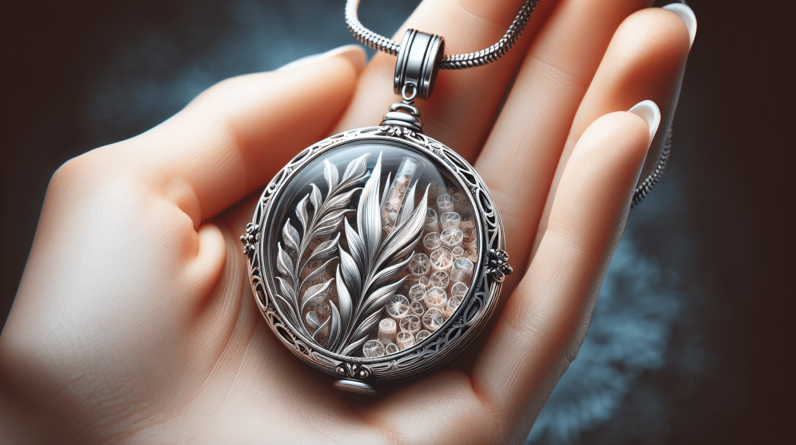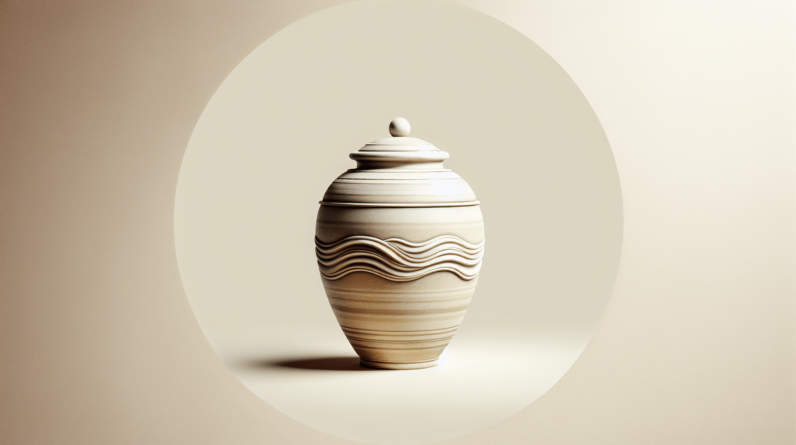
Losing a loved one is a difficult and emotional experience, and when choosing cremation as a final farewell, finding unique ways to honor their memory becomes even more important. From my experience working in the funeral industry, I have discovered several creative and heartfelt ways in which you can memorialize someone who has been cremated. Whether it’s scattering their ashes in a meaningful location, turning their ashes into jewelry, or creating a personalized artwork or memorial garden, there are countless options that allow you to celebrate their life in a truly unique and special way.
Creating Memorial Jewelry
Making jewelry with the cremation ashes
If you are looking for a unique and personal way to memorialize someone who has been cremated, consider creating memorial jewelry with their ashes. This can be a beautiful and meaningful way to keep their memory close to you at all times.
There are many skilled artisans who specialize in incorporating cremation ashes into jewelry pieces such as lockets or pendants. These pieces are often custom-designed and can be created to reflect the taste and style of your loved one.
By using a small portion of the cremation ashes, the artist can carefully encase them within glass or resin, creating a stunning and one-of-a-kind piece of jewelry. This allows you to carry a tangible reminder of your loved one with you wherever you go.
Incorporating the ashes into a locket or pendant
A locket or pendant is a classic and timeless piece of jewelry that can serve as a beautiful tribute to your loved one. By incorporating the ashes into a locket or pendant, you can create a piece that is not only visually stunning but also deeply meaningful.
You may choose to have the ashes placed inside a small compartment within the locket or pendant, allowing you to keep them securely enclosed. This compartment can be discreetly hidden or designed to be visible, depending on your preference.
Some artisans also offer the option of engraving the name or initials of your loved one on the locket or pendant, adding an extra personal touch to the piece. This can further enhance the sentimental value of the jewelry and make it a cherished heirloom for future generations.
Designing a personalized piece of memorial jewelry
When it comes to designing memorial jewelry, the possibilities are endless. From rings and bracelets to earrings and cufflinks, there are various options available to suit different tastes and preferences.
Consider working closely with a skilled jeweler who specializes in memorial pieces. By sharing your ideas, preferences, and any specific requests, you can collaborate to design a custom piece of jewelry that truly captures the essence and spirit of your loved one.
You can choose to incorporate symbolic elements, birthstones, or meaningful engravings that reflect the personality, hobbies, or passions of the deceased. This personalization adds a unique and special touch to the jewelry, making it a truly one-of-a-kind tribute.
Remember to communicate openly with the jeweler and provide any necessary information or materials, such as photographs or favorite quotes, that can help inspire the design. The result will be a piece of memorial jewelry that holds deep significance and brings comfort to you and your family.
Planting a Memorial Tree
Selecting a meaningful tree species
Planting a memorial tree is a beautiful way to honor the memory of your loved one while also contributing to the environment. When choosing a tree species, consider selecting one that holds special significance or has personal meaning to your loved one.
For example, if they were passionate about nature, you could plant a native tree species that is important to your region’s ecosystem. If they had a favorite tree, planting that particular species can serve as a personal tribute.
Researching different tree species can help you understand their growth requirements, ensuring that you choose a tree that will thrive in the chosen location. Seek advice from local nurseries, arborists, or horticulturists who can provide guidance on suitable tree species for your climate and soil conditions.
Planting the tree in a significant location
Choosing the right location to plant the memorial tree is crucial. Consider selecting a place that held special meaning for your loved one, such as their favorite park, their childhood backyard, or a scenic spot they loved to visit.
Ensure that the location you choose meets the specific needs of the tree species you have selected. Factors such as soil type, sunlight exposure, and adequate spacing should be taken into account to promote the tree’s healthy growth.
If you own the property where you plan to plant the tree, you may want to consider creating a small memorial garden or dedicated space around the tree. This can include a bench, stepping stones, or even a small plaque with the person’s name or a meaningful quote.
Adding a memorial plaque or marker
To further commemorate the planting of the memorial tree, you may choose to add a memorial plaque or marker. This can serve as a permanent reminder of your loved one’s life and the significance of the tree.
The plaque or marker can be engraved with their name, birth and death dates, and a personal message. It can be made from durable materials such as brass, stone, or ceramic to withstand outdoor conditions and stand the test of time.
By adding this personalized touch, you create a lasting tribute that not only preserves the memory of your loved one but also provides a place for family and friends to visit, reflect, and find solace.
Transforming Ashes into Art
Commissioning an artist to create a unique artwork with the ashes
Turning cremation ashes into art is a creative and meaningful way to honor the memory of your loved one. By commissioning an artist who specializes in working with ashes, you can create a unique and personalized artwork that captures their spirit and essence.
There are artists who excel in various mediums, such as painting, sculpture, or pottery, and can skillfully incorporate the ashes into their artwork. They can work closely with you to understand your vision, preferences, and any specific elements you would like to include.
Through their expertise, these artists can create a truly one-of-a-kind piece that reflects the personality, interests, or passions of the deceased. Whether it’s a painting inspired by their favorite landscape, a sculpture representing a beloved hobby, or a ceramic vessel displaying their ashes, the result will be a special and lasting tribute.
Turning the ashes into a glass sculpture or paperweight
Glass sculptures or paperweights made with cremation ashes are exquisite and delicate artworks that can be kept as cherished mementos. Through a meticulous process, the ashes are carefully fused with molten glass, resulting in a stunning and translucent piece that encapsulates the memory of your loved one.
The vibrant colors and unique patterns created within the glass can add a touch of beauty and symbolism to the artwork. You can choose to have the glass sculpture or paperweight displayed in your home, allowing it to serve as a constant reminder of your loved one and the special connection you shared.
Some artists also offer the option of incorporating additional elements, such as flowers or personal items, into the glass. This further customizes the piece and makes it truly representative of your loved one’s life and personality.
Creating a custom painting using the ashes as a medium
For those who appreciate the beauty of paintings, creating a custom artwork using the ashes as a medium can be a captivating way to honor the memory of your loved one. This unique approach transforms the ashes into a remarkable pigment that becomes an essential part of the artwork.
The artist will carefully incorporate the ashes into the paint, allowing them to become an integral part of the final piece. The result is a personalized painting that captures the essence and individuality of your loved one in a visually striking and emotionally powerful way.
By working closely with the artist and providing any relevant information or materials, such as photographs or favorite colors, you can ensure that the painting truly reflects the spirit and personality of the deceased. It will become a cherished artwork that preserves their memory and creates a meaningful connection.
Scattering the Ashes in a Meaningful Location
Choosing a location that held special significance to the deceased
Scattering the ashes of a loved one in a meaningful location can be a deeply personal and symbolic way to say goodbye. It allows you to release their physical remains into a place that held special significance to them during their lifetime.
Consider the places that were important to your loved one. It could be their favorite beach, a peaceful forest, or a scenic mountaintop. Reflecting on their passions, hobbies, or beloved memories can help guide you in choosing the perfect location for scattering their ashes.
Keep in mind that some locations may have restrictions or regulations regarding the scattering of ashes. It is important to research and obtain any necessary permissions or permits to ensure that the ceremony is carried out respectfully and in accordance with local laws.
Obtaining necessary permissions or permits for scattering ashes
Before scattering ashes in a specific location, it is important to check if any permissions or permits are required. Different countries, states, or counties may have specific regulations or restrictions regarding the scattering of ashes in public or private spaces.
Contacting the relevant authorities or organizations, such as local parks departments or environmental agencies, can provide you with the necessary information and guidance. They can inform you of any specific rules or guidelines you need to follow and help ensure that the scattering is conducted respectfully and legally.
By obtaining the proper permissions or permits, you can have peace of mind knowing that the final wishes of your loved one are being honored in a responsible and respectful manner.
Planning a ceremony or gathering for loved ones to say their final goodbyes
Scattering ashes in a meaningful location can be a deeply emotional experience for those left behind. To create a more meaningful and inclusive ceremony, consider planning a gathering or memorial service where family and friends can all come together to say their final goodbyes.
This can be an opportunity to share memories, stories, and reflections about the deceased, allowing loved ones to find closure and support one another during this difficult time. It can be as simple as a small gathering at the scattering site or a more elaborate event incorporating rituals, readings, or music.
You may also choose to hold a symbolic gesture during the scattering, such as releasing balloons, flowers, or birdseed, to symbolize the continuation of life and the release of the spirit. Personalize the ceremony to reflect the beliefs, values, or preferences of your loved one, creating a farewell that is truly meaningful and heartfelt.
Creating a Memory Capsule
Collecting mementos, photographs, and personal items of the deceased
A memory capsule is a personal and tangible way to preserve the memories and cherished moments of your loved one. Collecting mementos, photographs, and personal items can help create a comprehensive and meaningful collection that represents their life and legacy.
Consider gathering items that hold sentimental value or symbolize special memories. These can include photographs, letters, jewelry, favorite books or movies, or even small trinkets that were dear to the deceased.
Involve family and friends in the collection process, as they can provide valuable insights and contribute their own cherished items or memories. This collaborative effort ensures that the memory capsule becomes a true reflection of your loved one’s life and the impact they had on those around them.
Sealing the items in a waterproof and durable container
Protecting the items stored in the memory capsule is crucial to ensure their longevity and preservation. Choose a container that is waterproof, airtight, and durable, as this will safeguard the items from moisture, dust, and other potential damage.
Depending on your preference, you can select a traditional container such as a metal or wooden box, or opt for a more unique and personalized option. There are companies that specialize in creating custom memory capsules, allowing you to choose materials, designs, and engravings that honor the memory of your loved one.
Consider including a written note or letter that explains the significance of the items enclosed within the memory capsule. This creates a personal connection and provides context for future generations who may come across the capsule.
Burying or storing the memory capsule in a special place
Once the memory capsule is complete and the items are securely sealed within, the next step is to determine where it will be placed or stored. There are different options to consider, depending on your preferences and circumstances.
You may choose to bury the memory capsule in a special location, such as a favorite garden spot, a family cemetery plot, or a place of significance to your loved one’s life. This allows for a physical connection to the memory capsule and creates a designated space for remembrance.
Alternatively, if burying the memory capsule is not an option, you can find a secure and meaningful place to store it. This could be within your home, a safe deposit box, or a secure storage facility. Regardless of the chosen location, ensure that it is easily accessible to you and your family whenever you wish to revisit the memories and keepsakes inside.
By creating a memory capsule, you are not only preserving the legacy and memories of your loved one but also creating a lasting connection between past and present generations. It serves as a tangible reminder of their life, ensuring that their memory lives on for years to come.
Donating to Charity in the Deceased’s Name
Identifying a cause or organization that was important to the deceased
Donating to a charity or organization in memory of your loved one is a meaningful and impactful way to honor their life and the causes they cared about. Start by identifying a cause or organization that held significant importance to the deceased.
Reflect on the values, beliefs, or passions of your loved one. Consider the issues or areas they actively supported or advocated for during their lifetime. This could range from animal welfare to humanitarian efforts, environmental conservation to medical research, or education to social justice causes.
By selecting a cause that was near and dear to their heart, you ensure that your donation is aligned with their values and reflects their desire to make a positive impact in the world.
Researching reputable charities and ensuring they align with the deceased’s values
Before making a donation, it is important to research and confirm the legitimacy and reputation of the chosen charities or organizations. This ensures that your contributions will be used effectively and responsibly to support the cause your loved one held dear.
Utilize resources such as charity evaluation websites, online reviews, and testimonials to assess the credibility and effectiveness of the organizations you are considering. Look for transparency in financial reporting and a track record of responsible and impactful work.
Engage in conversations with representatives from the charities to gather more information about their programs, goals, and how the donation will be utilized. This will allow you to make an informed decision and ensure that your contribution will truly make a difference in the areas your loved one cared about.
Making a donation in memory of the deceased and sharing the acknowledgment with loved ones
Once you have identified a reputable charity and made the donation, it is a beautiful gesture to share the acknowledgment with your family and friends. This allows others to know about the impact they are making in memory of your loved one and may even inspire them to contribute as well.
Sending a personalized acknowledgment to family members, close friends, or those who made contributions on behalf of your loved one can be a thoughtful way to express gratitude and share the impact of the donation. This can be done through a heartfelt letter, email, or even a special card.
Consider creating a dedicated page on a family website or social media platform, where updates about the cause and the progress made can be shared. This creates a sense of community and connection, allowing others to continue supporting the cause and keeping the memory of your loved one alive.
Constructing a Memorial Bench or Stone
Designing and building a bench or stone featuring the name and life dates of the deceased
Constructing a memorial bench or stone is a lasting and impactful way to honor the memory of your loved one. These physical structures provide a permanent place for remembrance and reflection, allowing family and friends to gather and pay tribute.
Start by designing a bench or stone that reflects the personality and style of your loved one. Consider incorporating their name, birth, and death dates, as well as any meaningful symbols or quotes that represent their life.
Consult with a skilled craftsman or stonemason who specializes in creating memorial structures. They can guide you through the design process, recommend suitable materials, and ensure that the bench or stone meets your requirements and withstands the test of time.
Choosing a suitable location for the memorial
Selecting the right location for the memorial bench or stone is crucial to ensure that it is accessible, visible, and in a place of significance. Consider places that held special meaning to your loved one, such as a favorite park, a beautiful garden, or a serene waterfront.
Engage in conversations with local authorities, park departments, or private property owners to obtain permission and guidance for installing the memorial structure. They can assist you in choosing an appropriate location that adheres to any relevant regulations or guidelines.
Ensure that the chosen location is peaceful and contemplative, providing a tranquil setting for individuals to honor and remember your loved one. It should be a place where their memory can be cherished and celebrated by all who visit.
Installing the bench or stone in a public or private space
Once you have designed and secured permission for the memorial bench or stone, it is time to ensure its proper installation. Work closely with the craftsman or stonemason to coordinate the construction, transportation, and placement of the structure.
If the bench or stone is being installed in a public space, make sure to follow any procedures or regulations set by the relevant authorities. Coordinate with them to determine the optimal time for installation, allowing for minimal disruption to park visitors or surrounding areas.
For installation in a private space, ensure that all necessary preparations are made to properly accommodate the structure. This may involve excavation, landscaping modifications, or the creation of a dedicated memorial garden.
By taking care during the installation process, you ensure that the memorial bench or stone becomes a lasting tribute that offers solace, comfort, and a place for remembrance for generations to come.
Creating a Memorial Website or Online Tribute
Building a dedicated website or webpage to honor the deceased
In the digital age, creating a memorial website or online tribute is a modern and inclusive way to honor the memory of your loved one. Such a platform allows friends and family from near and far to come together, share memories, and celebrate the life of the deceased.
Start by building a dedicated website or webpage that is solely dedicated to the memory of your loved one. This can be done using platforms that offer user-friendly website creation tools, or you may opt to hire a web developer to create a more customized experience.
Consider including the person’s name, photographs, and a brief biography to introduce visitors to their life and achievements. You can also provide information about memorial events, fundraising efforts, or charities that were important to your loved one.
Including photos, videos, stories, and memories
An essential part of a memorial website or online tribute is the inclusion of photos, videos, stories, and memories. These elements help paint a vivid picture of your loved one’s life while allowing visitors to connect, reminisce, and contribute their own tributes.
Gather a collection of photographs and videos that span different stages of your loved one’s life. These can include candid moments, special occasions, family gatherings, or even short video clips where they may be telling a story, singing a song, or participating in a favorite hobby.
Encourage family and friends to share their own memories, stories, or anecdotes about the deceased. This not only fosters a sense of connection among loved ones but also creates a comprehensive and heartfelt tribute that captures the essence of your loved one.
Allowing family and friends to contribute their own tributes
One of the beautiful aspects of a memorial website or online tribute is the ability for family and friends to contribute their own tributes and remembrances. This creates a space for collective grieving and celebration, as individuals from various backgrounds come together to honor the memory of your loved one.
Provide a designated area on the website where visitors can leave messages, share stories, or upload their own photos and videos. This interactive feature allows for a sense of community and participation, showing the impact your loved one had on the lives of others.
Consider creating a guestbook where visitors can express their condolences and share their personal memories. This not only serves as a lasting testament to the impact your loved one had on those around them but also provides comfort and support during a time of loss.
By creating a memorial website or online tribute, you ensure that the memory of your loved one lives on beyond physical boundaries. It offers a space for reflection, connection, and celebration, allowing family and friends to come together and find solace in their shared memories.
Designing a Memorial Tattoo
Creating a custom tattoo design incorporating elements that represent the deceased
Designing a memorial tattoo is a deeply personal and permanent way to honor the memory of your loved one. By creating a custom design that incorporates elements that represent them, you can create a unique and meaningful tribute that serves as a constant reminder of their presence in your life.
Start by reflecting on the interests, passions, or beliefs that were important to your loved one. Consider symbols, images, or quotes that resonate with their personality or life journey. These elements can be used as inspiration when working with a talented tattoo artist to create the design.
Communicate openly with the tattoo artist, sharing your ideas, preferences, and any specific requests you may have. Together, you can collaborate to design a tattoo that captures the essence, energy, and impact of your loved one.
Choosing a talented and reputable tattoo artist
Selecting a talented and reputable tattoo artist is crucial when it comes to creating a memorial tattoo. Take the time to research and identify artists who specialize in memorial tattoos or have a strong understanding of the emotional significance of these tattoos.
Look for artists who have a solid portfolio showcasing their skill and versatility. Pay attention to their attention to detail, ability to capture emotions in their artwork, and their sensitivity when it comes to memorial tattoos.
Seek recommendations from friends, family, or support groups who have had memorial tattoos created. They can provide valuable insights and personal experiences to help you make an informed decision.
Getting the tattoo in a meaningful location on the body
When deciding on the placement of a memorial tattoo, consider selecting a meaningful location on your body. This adds an extra layer of personalization and ensures that the tattoo is a constant reminder of your loved one’s memory.
Some individuals choose to get the tattoo in a visible area, allowing it to serve as a public tribute or conversation starter. Others prefer a more intimate location, such as their chest, arm, or back, to keep the tattoo more personal and private.
Think about your own comfort, lifestyle, and preferences when selecting the location for the tattoo. Consult with the tattoo artist to determine the feasibility of the design, taking into account any potential future modifications or additions you may want to make.
By taking the time to design and select a memorial tattoo that resonates with you, you ensure that the memory of your loved one lives on in a tangible and permanent way. It becomes a personal and unique tribute, allowing you to carry their presence with you wherever you go.
Hosting an Annual or Special Event
Organizing a yearly gathering or event in honor of the deceased
Hosting an annual or special event in honor of the deceased is a wonderful way to celebrate their life, share memories, and bring together loved ones. By organizing a gathering, you create an opportunity for family and friends to come together, support one another, and continue to honor the memory of your loved one.
Consider organizing an event that reflects the personality, interests, or passions of the deceased. This could be a picnic in their favorite park, a charity walk or run supporting a cause they cared about, a memorial concert featuring their favorite music, or even a themed party that celebrates their hobbies or accomplishments.
Communicate with family and friends to determine their availability, preferences, and ideas for the event. This collaborative effort helps ensure that the gathering is inclusive, meaningful, and a testament to the impact your loved one had on those around them.
Selecting activities or themes that reflect the individual’s personality and interests
When planning the annual or special event, it is important to select activities or themes that reflect the personality and interests of your loved one. By incorporating elements that were important to them, you create an event that is unique, engaging, and a true representation of their life.
Consider organizing activities or workshops that showcase their hobbies, such as gardening, cooking, or painting. You could invite guest speakers or performers who were influential in their life or who represent causes they supported. Creating spaces for art installations, storytelling, or group discussions can further engage attendees and encourage the sharing of memories.
By ensuring that the event celebrates your loved one’s passions and interests, you create an atmosphere of joy, connection, and remembrance. Family and friends will be able to participate in activities that would have resonated with the person they are commemorating, allowing for a deeper connection to their memory.
Inviting friends, family, and loved ones to participate and celebrate the person’s life
The success of an annual or special event relies on the participation and presence of family, friends, and loved ones. Make sure to invite individuals who were close to your loved one and allow them to contribute to the event in meaningful ways.
Send out personalized invitations that reflect the theme or purpose of the event. Include information about the activities, the schedule, and any specific requests or ideas you have for their participation.
Encourage attendees to share their memories, stories, or tributes during the event. This can be done through speeches, open mic sessions, or written messages that are collected and shared with all participants.
Create spaces or memory boards where guests can leave photographs, notes, or mementos that capture their own personal memories of the deceased. This allows for a collective sharing of stories and the creation of a physical representation of the impact the person had on those around them.
By hosting an annual or special event, you provide a space for remembrance, celebration, and connection. Through the shared experiences, stories, and memories, you ensure that the memory of your loved one lives on and continues to inspire and unite those they left behind.
In conclusion, there are countless unique and meaningful ways to memorialize someone who has been cremated. Whether it is through creating memorial jewelry, planting a tree, transforming ashes into art, scattering the ashes in a significant location, creating a memory capsule, donating to charity in their name, constructing a memorial bench or stone, designing a memorial tattoo, hosting an annual or special event, or creating a memorial website or online tribute, each approach allows you to tailor the memorial to reflect the life, personality, and legacy of your loved one. By choosing a method that resonates with you and your family, you create a lasting tribute that ensures their memory lives on and brings comfort and solace to all who remember them.






